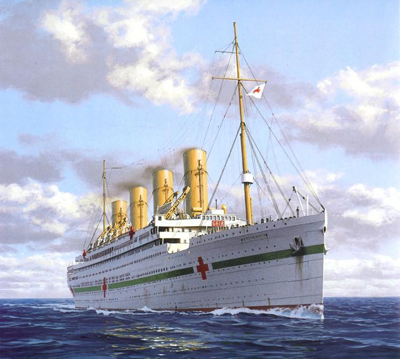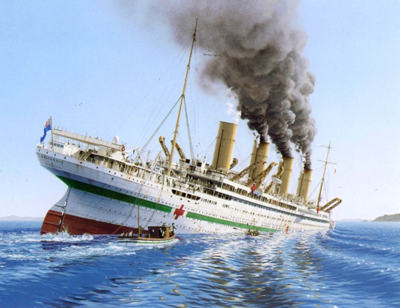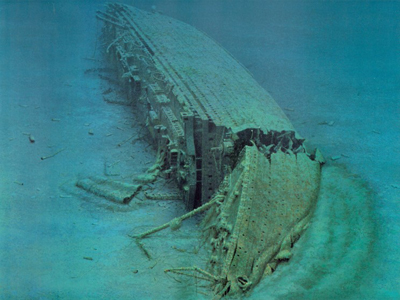Most everyone is familiar with the story of the ocean liner Titanic, or maybe has seen the 1997 epic film “Titanic”. The RMS (Royal Mail Steamer) Titanic tragically sank on her maiden voyage Sunday April 14, 1912 after hitting an iceberg. 1,589 passengers and crew perished due to a shortage of lifeboats. Most people do not know that the Titanic had an identical sister ship named the Britannic that sank in a somewhat similar way in 1916. Here is her story:
Britannic was the third and largest Olympic-class ocean liner of the England based White Star Line. She was the sister-ship of RMS Olympic and RMS Titanic and was intended to enter service as a transatlantic ocean liner. At 882 feet 9 inches long Britannic was the largest ocean liner of the time. Records have been found showing that Britannic was originally named Gigantic, but for reasons unknown the name was changed. Some historians claim the name was changed after the Titanic tragedy to avoid a similar name as her ill-fated sister-ship. The Britannic was still being built when the Titanic sank. After the public outcry that followed the loss of the Titanic, the Britannic was redesigned with better watertight protection. Six sets of massive crane-like lifeboat hoists were added that could carry six lifeboats each. Britannic was finally launched at the Harland and Wolff shipyard in Belfast, Ireland on February 26, 1914.

HMHS Britannic at sea Portrait by Ken Marschall
Before Britannic could enter service as a passenger carrying ocean liner, World War I broke out in Europe and the ship was placed in storage. On November 13, 1915, Britannic was requisitioned as a hospital ship by the Royal Navy and was removed from her storage location at Belfast. Renamed HMHS (His Majesty’s Hospital Ship) Britannic was turned into a hospital ship and was repainted white with large red crosses and a horizontal green stripe. Britannic completed five round trip voyages to the Mediterranean Sea and back to Southampton England carrying sick and wounded soldiers from the Gallipoli Campaign, also known as the Dardanelles Campaign or the Battle of Gallipoli.

Rare photograph of the Britannic in service as a Hospital Ship Photo courtesy of 20thcenturyliners.co
November 12, 1916 found the Britannic departing Southampton on her sixth voyage to the Mediterranean under the command of Captain Charles Bartlett. The morning of November 21, 1916 found the Britannic peacefully sailing off of the Greek island of Kea. The humid weather had prompted many of the nurses to open portholes in the sides of the ship to help ventilate the hospital rooms which had been converted from passenger cabins. At 8:12 AM a massive explosion shook the ship and the Britannic began taking in water at the bow, or front of the ship, much like her sister ship Titanic four years before.
Captain Bartlett ordered the automatic watertight doors closed that separated the ships main compartments, sent a distress signal, and ordered the crew to prepare the lifeboats. Unfortunately some of the watertight doors failed to close properly. As the Britannic settled deeper into the water, water started to flow into other compartments of the ship through the portholes left open by the nurses. On the bridge, Captain Bartlett was trying to save the ship. In about ten minutes the Britannic was roughly in the same condition the Titanic was one hour after her collision with the iceberg. Captain Bartlett saw the shores of Kea about three miles away and decided to make an effort to sail the ship into shallow water before it sank.

Portrait of the wreck of the Britannic by Ken Marschall
Some of the crew started to panic and launched some lifeboats before being ordered to do so. As the Britannic’s engines were still running, and the stern, or rear of the ship was starting to rise out of the water, two of these lifeboats floated into the turning propellers. Both lifeboats, together with their occupants, were ripped to pieces. After Captain Bartlett heard about this he gave the order to stop the engines. The propellers stopped turning right before a third lifeboat was about to be destroyed. The occupants of this lifeboat pushed against one of the propellers and got away safely. Captain Bartlett then gave the order to lower the lifeboats and at 8:35 AM, he gave the order to abandon ship.
At 9:00 AM, Captain Bartlett sounded one long blast on the Britannic’s main steam whistle and then swam to a lifeboat and began to coordinate the rescue operations. The final whistle blow was the evacuation signal for the ship’s engineers who, like their heroic colleagues on the Titanic, had remained at their posts until the last possible moment. The Britannic rolled over onto her side and sank at 9:07 AM, only fifty-five minutes after the explosion, unlike her sister ship Titanic which stayed afloat for two hours and forty minutes after her collision with the iceberg.
Nurse Violet Jessop (who was a stewardess on the Titanic and survived its sinking), described the last moments of the Britannic: “She dipped her head a little, then a little lower and still lower. All the deck machinery fell into the sea like a child’s toys. Then she took a fearful plunge, her stern rearing hundreds of feet into the air until with a final roar, she disappeared into the depths, the noise of her going resounding through the water with undreamt-of violence….”

Violet Jessop (1887 - 1971) who achieved fame by surviving the disastrous sinkings of both the RMS Titanic and HMHS Britannic.
First to arrive on the scene were Greek fishermen from Kea who picked up many survivors from the water. Afterwards HMS Scourge and HMS Heroic arrived and started rescuing occupants of the lifeboats. Out of 1,036 crew, nurses, doctors, and patients only thirty lost their lives in the sinking. The mystery of the explosion that sank the Britannic was not immediately known. Was it a torpedo from a submarine? Or a naval mine? (A naval mine is a self-contained floating explosive device anchored by a cable to an anchor in water to destroy ships) No one knew for sure. After World War I, German records revealed that the German Submarine U-73 had laid several naval mines in the area where Britannic sank, but this was never proven as the cause of her sinking. The Britannic was the largest ship sunk in World War I.
The wreck of the Britannic was discovered in 1975 by famous undersea explorer Jacques Cousteau. The wreck of the Britannic is in 400 feet of water lying on its side; the bow of the ship is deformed and almost ripped off from the rest of the wreck. The next visitor to the wreck site was in 1995 when Dr. Robert Ballard explored the wreck. Ballard was also part of the team that first discovered the Titanic in 1985.
More expeditions to Britannic have followed with some major discoveries being made. In 2003, an expedition led by Carl Spencer sent scuba divers into the wreck; Spencer’s expedition found that several watertight doors were open that should have automatically closed after the explosion. Also in 2003 several naval mine anchors were located near the Britannic’s final resting place by Sonar expert Bill Smith, confirming the German records of U-73 and proving that Britannic was probably sunk by a naval mine and that the damage was compounded by open portholes and watertight doors not closing.
The Britannic’s original plans included a Welte Philharmonic Organ. Due to World War I, the organ was never delivered. In 2007 during the restoration of the Welte Organ in the Swiss National Museum, the restorers detected that the main parts of the instrument were marked by the German organ builders with “Britanik”. Records in Germany have since proved that this organ was indeed built for the Britannic, Titanic’s forgotten sister.
